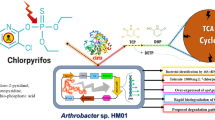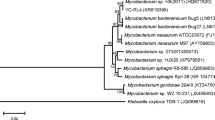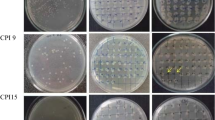Abstract
Strain Yw12, isolated from activated sludge, could completely degrade and utilize methyl parathion as the sole carbon, phosphorus and energy sources for growth in the basic salt media. It could also completely degrade and utilize p-nitrophenol as the sole carbon and energy sources for growth in the minimal salt media. Phenotypic features, physiological and biochemical characteristics, and phylogenetic analysis of 16S rRNA sequence showed that this strain belongs to the genus of Agrobacterium sp. Response surface methodology was used to optimize degradation conditions. Under its optimal degradation conditions, 50 mg l−1 MP was completely degraded within 2 h by strain Yw12 and the degradation product PNP was also completely degraded within 6 h. Furthermore, strain Yw12 could also degrade phoxim, methamidophos, chlorpyrifos, carbofuran, deltamethrin and atrazine when provided as the sole carbon and energy sources. Enzymatic analysis revealed that the MP degrading enzyme of strain Yw12 is an intracellular enzyme and is expressed constitutively. These results indicated that strain Yw12 might be used as a potential and effective organophosphate pesticides degrader for bioremediation of contaminated sites.





Similar content being viewed by others
References
Bhatti ZI, Toda H, Furukawa K (2002) p-nitrophenol degradation by activated sludge attached on nonwovens. Water Res 36:1135–1142
Bhushan B, Chauhan A, Samanta SK, Jain RK (2000) Kinetics of biodegradation of p-nitrophenol by different bacteria. Biochem Biophys Res Commun 274:626–630
Bourassa S, Vadeboncoeur C (1992) Expression of an inducible enzyme II fructose and activation of a cryptic enzyme II glucose in glucose-grown cells of spontaneous mutants of Streptococcus salivarius lacking the low-molecular-mass form of IIIman, a component of the phosphoenolpyruvate:mannose phosphotransferase system. J Gen Microbiol 138:769–777
Brown K (1980) Phosphotriesterases of Flavobacterium sp. Soil Biol Biochem 12:105–112
Chaudhry GR, Ali AN, Wheeler WB (1988) Isolation of a methyl parathion-degrading Pseudomonas sp. that possesses DNA homologous to the opd gene from a Flavobacterium sp. Appl Environ Microbiol 54:288–293
De Crombrugghe B, Perlman RL, Varmus HE, Pastan I (1969) Regulation of inducible enzyme synthesis in Escherichia coli by cyclic adenosine 3′,5′-monophosphate. J Biol Chem 244:5828–5835
Dumas DP, Durst HD, Landis WG, Raushel FM, Wild JR (1990) Inactivation of organophosphorus nerve agents by the phosphotriesterase from Pseudomonas diminuta. Arch Biochem Biophys 277:155–159
Feng X, Ou LT, Ogram A (1997) Plasmid-mediated mineralization of carbofuran by Sphingomonas sp. strain CF06. Appl Environ Microbiol 63:1332–1337
Gangming Xu, Zheng Wei, Yingying Li, Wang Shenghui, Zhang Jingshun, Yan Y (2008) Biodegradation of chlorpyrifos and 3,5,6-trichloro-2-pyridinol by a newly isolated Paracoccus sp. strain TRP. Int Biodeterior Biodegrad 62:51–56
Gao J et al (2009) The occurrence and spatial distribution of organophosphorous pesticides in Chinese surface water. Bull Environ Contam Toxicol 82:223–229
Guo WQ et al (2009) Optimization of culture conditions for hydrogen production by Ethanoligenens harbinense B49 using response surface methodology. Bioresour Technol 100:1192–1196
Holt JG, Krieg NR, Sneath PH, Staley JT, Williams ST (1994) Bergey’s manual of determinative bacteriology, 9th edn. Williams and Wilkins, Baltimore
Jiang J, Zhang R, Li R, Gu JD, Li S (2007) Simultaneous biodegradation of methyl parathion and carbofuran by a genetically engineered microorganism constructed by mini-Tn5 transposon. Biodegradation 18:403–412
Kadiyala V, Spain JC (1998) A two-component monooxygenase catalyzes both the hydroxylation of p-nitrophenol and the oxidative release of nitrite from 4-nitrocatechol in Bacillus sphaericus JS905. Appl Environ Microbiol 64:2479–2484
Kellogg ST, Chatterjee DK, Chakrabarty AM (1981) Plasmid-assisted molecular breeding: new technique for enhanced biodegradation of persistent toxic chemicals. Science 214:1133–1135
Kim JR, Ahn YJ (2009) Identification and characterization of chlorpyrifos-methyl and 3,5,6-trichloro-2-pyridinol degrading Burkholderia sp. strain KR100. Biodegradation 20:487–497
Krishna KR, Philip L (2008) Biodegradation of lindane, methyl parathion and carbofuran by various enriched bacterial isolates. J Environ Sci Health B 43:157–171
Kulkarni M, Chaudhari A (2006) Biodegradation of p-nitrophenol by Pseudomonas putida. Bioresoure Technol 97:982–988
Lai K, Stolowich NJ, Wild JR (1995) Characterization of P–S bond hydrolysis in organophosphorothioate pesticides by organophosphorus hydrolase. Arch Biochem Biophys 318:59–64
Li YY, Zhou B, Li W, Peng X, Zhang JS, Yan YC (2008) Mineralization of p-nitrophenol by a new isolate Arthrobacter sp. Y1. J Environ Sci Health B 43:692–697
Li W et al (2009) Biodegradation and detoxification of endosulfan in aqueous medium and soil by Achromobacter xylosoxidans strain CS5. J Hazard Mater 167:209–216
Liu H, Zhang JJ, Wang SJ, Zhang XE, Zhou NY (2005) Plasmid-borne catabolism of methyl parathion and p-nitrophenol in Pseudomonas sp. strain WBC-3. Biochem Biophys Res Commun 334:1107–1114
McDaniel CS, Harper LL, Wild JR (1988) Cloning and sequencing of a plasmid-borne gene (opd) encoding a phosphotriesterase. J Bacteriol 170:2306–2311
Mohana S, Shah A, Divecha J, Madamwar D (2008) Xylanase production by Burkholderia sp. DMAX strain under solid state fermentation using distillery spent wash. Bioresour Technol 99:7553–7564
Mulbry WW, Karns JS (1989) Purification and characterization of three parathion hydrolases from gram-negative bacterial strains. Appl Environ Microbiol 55:289–293
Mulbry WW, Karns JS, Kearney PC, Nelson JO, McDaniel CS, Wild JR (1986) Identification of a plasmid-borne parathion hydrolase gene from Flavobacterium sp. by southern hybridization with opd from Pseudomonas diminuta. Appl Environ Microbiol 51:926–930
Munnecke D, Hsieh D (1976) Pathway of microbial metabolism of parathion. Appl Environ Microbiol 31:63–69
Myers CR, Myers JM (1992) Localization of cytochromes to the outer membrane of anaerobically grown Shewanella putrefaciens MR-1. J Bacteriol 174:3429–3438
Pakala SB et al (2007) Biodegradation of methyl parathion and p-nitrophenol: evidence for the presence of a p-nitrophenol 2-hydroxylase in a Gram-negative Serratia sp. strain DS001. Appl Microbiol Biotechnol 73:1452–1462
Qiu XH, Bai WQ, Zhong QZ, Li M, He FQ, Li BT (2006) Isolation and characterization of a bacterial strain of the genus Ochrobactrum with methyl parathion mineralizing activity. J Appl Microbiol 101:986–994
Ramanathan MP, Lalithakumari D (1999) Complete mineralization of methylparathion by Pseudomonas sp. A3. Appl Biochem Biotechnol 80:1–12
Rani NL, Lalithakumari D (1994) Degradation of methyl parathion by Pseudomonas putida. Can J Microbiol 40:1000–1006
Raveh L et al (1992) Protection against tabun toxicity in mice by prophylaxis with an enzyme hydrolyzing organophosphate esters. Biochem Pharmacol 44:397–400
Rehman A, Raza ZA, Afzal M, Khalid ZM (2007) Kinetics of p-nitrophenol degradation by Pseudomonas pseudomallei wild and mutant strains. J Environ Sci Health A Tox Hazard Subst Environ Eng 42:1147–1154
Roodveldt C, Tawfik DS (2005a) Directed evolution of phosphotriesterase from Pseudomonas diminuta for heterologous expression in Escherichia coli results in stabilization of the metal-free state. Protein Eng Des Sel 18:51–58
Roodveldt C, Tawfik DS (2005b) Shared promiscuous activities and evolutionary features in various members of the amidohydrolase superfamily. Biochemistry 44:12728–12736
Scott C et al (2008) The enzymatic basis for pesticide bioremediation. Indian J Microbiol 48:65–79
Shen YJ, Lu P, Mei H, Yu HJ, Hong Q, Li SP (2010) Isolation of a methyl parathion-degrading strain Stenotrophomonas sp. SMSP-1 and cloning of the ophc2 gene. Biodegradation 21:785–792
Singh BK, Walker A (2006) Microbial degradation of organophosphorus compounds. FEMS Microbiol Rev 30:428–471
Spain JC, Gibson DT (1991) Pathway for biodegradation of p-nitrophenol in a Moraxella sp. Appl Environ Microbiol 57:812–819
Tamura K, Nei M, Kumar S (2004) Prospects for inferring very large phylogenies by using the neighbor-joining method. Proc Natl Acad Sci USA 101:11030–11035
Tamura K, Dudley J, Nei M, Kumar S (2007) MEGA4: molecular evolutionary genetics analysis (MEGA) software version 4.0. Mol Biol Evol 24:1596–1599
Tripathi AM, Agarwal RA (1998) Molluscicidal and anti-AChE activity of tertiary mixtures of pesticides. Arch Environ Contam Toxicol 34:271–274
Tse H, Comba M, Alaee M (2004) Method for the determination of organophosphate insecticides in water, sediment and biota. Chemosphere 54:41–47
van der Meer JR (1994) Genetic adaptation of bacteria to chlorinated aromatic compounds. FEMS Microbiol Rev 15:239–249
Wang L, Wen Y, Guo X, Wang G, Li S, Jiang J (2010) Degradation of methamidophos by Hyphomicrobium species MAP-1 and the biochemical degradation pathway. Biodegradation 21:513–523
Watkins LM, Mahoney HJ, McCulloch JK, Raushel FM (1997) Augmented hydrolysis of diisopropyl fluorophosphate in engineered mutants of phosphotriesterase. J Biol Chem 272:25596–25601
Xinghui Qiu QZ, Mei Li, Bai Wenqin, Li Baotong (2007) Biodegradation of p-nitrophenol by methyl parathion-degrading Ochrobactrum sp. B2. Int Biodeterior Biodegrad 59(4):297–301
Xu G, Li Y, Zheng W, Peng X, Li W, Yan Y (2007) Mineralization of chlorpyrifos by co-culture of Serratia and Trichosporon spp. Biotechnol Lett 29:1469–1473
Yang L, Zhao YH, Zhang BX, Yang CH, Zhang X (2005) Isolation and characterization of a chlorpyrifos and 3,5,6-trichloro-2-pyridinol degrading bacterium. FEMS Microbiol Lett 251:67–73
Zhang R, Cui Z, Jiang J, He J, Gu X, Li S (2005) Diversity of organophosphorus pesticide-degrading bacteria in a polluted soil and conservation of their organophosphorus hydrolase genes. Can J Microbiol 51:337–343
Zhang Z, Hong Q, Xu J, Zhang X, Li S (2006) Isolation of fenitrothion-degrading strain Burkholderia sp. FDS-1 and cloning of mpd gene. Biodegradation 17:275–283
Zhang J, Sun Z, Li Y, Peng X, Li W, Yan Y (2009) Biodegradation of p-nitrophenol by Rhodococcus sp. CN6 with high cell surface hydrophobicity. J Hazard Mater 163:723–728
Zhang C et al (2010) Biodegradation of beta-cypermethrin by two Serratia spp. with different cell surface hydrophobicity. Bioresour Technol 101:3423–3429
Zhongli C, Shunpeng L, Guoping F (2001) Isolation of methyl parathion-degrading strain M6 and cloning of the methyl parathion hydrolase gene. Appl Environ Microbiol 67:4922–4925
Acknowledgments
We thank Shubo Gu (College of Agricultural Sciences, Shandong Agricultural University) for providing facilities and helping with GC analysis. We are most grateful to MARahman for critical reading of the manuscript. This study was supported by Hi-Tech Research and Development Program of China (No. 2008AA10Z402) and Basic Research Fund of CAAS (Nos. 0042009001, 0042011006).
Author information
Authors and Affiliations
Corresponding author
Rights and permissions
About this article
Cite this article
Wang, S., Zhang, C. & Yan, Y. Biodegradation of methyl parathion and p-nitrophenol by a newly isolated Agrobacterium sp. strain Yw12. Biodegradation 23, 107–116 (2012). https://doi.org/10.1007/s10532-011-9490-0
Received:
Accepted:
Published:
Issue Date:
DOI: https://doi.org/10.1007/s10532-011-9490-0




